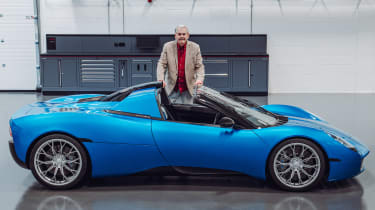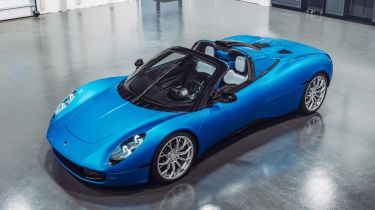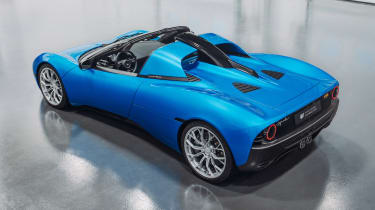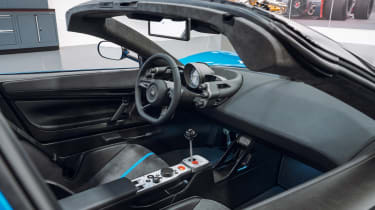New Gordon Murray Automotive T.33 Spider revealed
The Spider convertible version of the GMA T.33 has arrived
Gordon Murray has already sold out the T.50 hypercar, its T.50s Niki Lauda track version and the ‘everyday’ T.33 supercar. Now the designer of the legendary McLaren F1 is opening up the order books on the last of those models, with the new T.33 Spider.
Limited to 100 examples, the Gordon Murray Automotive (GMA) T.33 Spider uses the same basic construction as the T.33. In fact, the original design for the chassis was created to deliver specific rigidity for the open variant, so the increase in weight between the fixed-head and the Spider is just 18kg.
That means that the T.33 Spider tips the scales at just 1,108kg – an extremely light weight for a vehicle that, like the regular T.33, packs a mildly detuned and reworked version of the T.50’s 3.9-litre Cosworth-developed V12 engine. It has 609bhp and 451Nm of torque – 75 per cent of which is available from as low as 2,500rpm – and the engine weighs just 178kg, making it the lightest production V12 in the world. GMA has not issued performance figures but it’s believed the Spider’s top speed will be in excess of 200mph.
GMA originally planned to offer the T.33 with a choice of manual gearbox or a seamless-shift automatic. But Murray now admits that only a handful of the car’s 100 customers requested the two-pedal configuration, forcing the firm to abandon its development and offer those buyers either a manual car or a refund. As such, the T.33 Spider is available only with a six-speed manual transmission.
GMA T33 Spider design
Murray admits he sketched both T.33s at the same time and the Spider maintains the clean, simple approach that defined the coupé and made it stand out in comparison with the ultra-extreme T.50. Every panel beyond the A-pillar is unique to the new arrival, although its overall length remains the same as the hard-top’s – 4,398mm, so just one millimetre longer than the current Porsche 718 Boxster – and there are still distinctive haunches over the front and rear wheelarches.
The fixed section of the roof has buttresses that blend into a bespoke louvred rear deck, and the cabin has a rear window that can lower electrically to allow more of the engine noise to be enjoyed. The ram-induction airbox, another key T.33 feature, is even more noticeable on the Spider when the roof panels are removed.
The roof itself is composed of two carbon-fibre panels that can be removed and stored in “around a minute”, according to GMA. They’ll clip into position under the bonnet, eating into the area’s 115 litres of luggage space. But the T.33 Spider retains a surprising amount of practicality anyway, with a pair of ‘luggage lockers’ that run along the flanks, between the cabin and the rear wheels, offering a combined 180 litres of space.
The car seen in these initial images will change slightly for production, incidentally; the header rail of the windscreen will move forwards a little to make it easier to get in and out of the cabin. And the leading shutline for the front boot will also change, in a bid to improve practicality.
The different body treatment will allow greater scope for personalisation on the Spider, since the roof panels and rear deck can contrast with rest of the vehicle. “We’ve had a lot of fun already with it,” Murray told us. “Darker body colours in particular work well with a lighter rollover bar; it has that seventies ‘targa’ vibe about it. We’re expecting customers to really push it with the Spider, more than with the T.33.”
Interior and technology
The cabin, meanwhile, features the same simple layout as the regular T.33, with a central rev-counter in the instrument cluster, calibrated to 11,100rpm. There are secondary displays for climate control and the infotainment, which features wireless Apple CarPlay and Android Auto connectivity. The steering wheel is made from carbon fibre but clad in leather, and the carbon-fibre race-inspired seats are finished in a mixture of leather and Alcantara.
The first customer examples of the three-seat, fan-assisted T.50 hypercar are now being built, with initial deliveries expected in the coming weeks. That car and its hardcore T.50S Niki Lauda stablemate will be built in sequence at the firm’s Dunsfold facility. The T.33 will enter production in 2024 on a line currently under construction at the Gordon Murray Group’s new headquarters in Windlesham, Surrey – and once its 100-strong run has been completed, the T.33 Spider should start reaching owners in 2025.
The T.33 Spider will officially go on sale this week – but Murray admits that GMA’s sales team have already been in discussions with “the customer family” and that those existing clients have snapped up close to half of the examples on offer. No official price has been revealed but Murray said the company is “taking a slight hit” on the fixed-roof T.33 (£1.37million plus taxes), because of a price agreement and rising material costs. Expect the T.33 Spider’s numbers to have been calculated with inflation in mind, therefore; a figure of around £1.9million seems likely.
Higher performance version
Murray admits that a more “performance-oriented” version of the T.33 is likely to complete the planned 300-vehicle manufacturing run in 2026. It’s likely to do away with the first two cars’ clean look, adopting some form of fixed wings to at least double the aerodynamic downforce at speed. This, in turn, is likely to mean a stiffer suspension set-up that’s better suited to high-speed track days than long-distance road trips.
Work has also just started on the follow-up to the T.33, which is labelled ‘Project Three’ and should arrive in 2026. It’s expected to make further use of the V12 engine, although emissions rules across Europe and, in particular, the United States will determine if the motor can continue to be deployed without any electrical assistance. “We’re looking hard at that now,” Murray told Auto Express. “All we can say at present is that if we do have to look at hybridisation, it will be the very least we can get away with.”
Q&A With Gordon Murray

Q: With many supercars, there are significant compromises when it comes to opening up the fixed-roof vehicle. Did you have that problem with the Spider?
A: No, not at all. The original T.33 chassis was engineered with goals for the Spider, so we worked back from that. That’s why this car is only 18kg heavier than the regular T.33; the structure was made for it in the first place, so there weren’t really any nasty surprises.
Q: Was the roof solution the only one that you seriously considered?
A: We looked at everything, to be fair. A folding hard-top was discounted early on, because there are weight and complexity issues, not to mention packaging. Then we did consider fabric but I spent many years driving a Smart Roadster and while it never leaked, it always felt like it was about to. With the removable carbon-fibre panels, there’s none of that; it’s the best of both worlds, really.
Q: You’ve gone for a noticeably brighter colour on the show car than with other GMA vehicles.
A: We’ve actually played with pretty vivid colours before, on the first T.50 and then the T.33, but we chickened out. And in fact, many customers have been bolder than we were; there are only a couple of silver T.50s, for example. So with the Spider we decided to go for something more striking – something that would look good on the sort of sunny day when you might open it up.
Q: Do you expect that your existing T.33 owners will account for the majority of sales?
A: There’s been a lot of interest, certainly, but it’ll be interesting to see. Around 30 T.50 customers bought a T.33, which I can kind of understand, because the T.33 is so much more of an everyday car. Whether that will be as applicable with the Spider remains to be seen. But precisely half of the T.33 production run is going to the United States, and I’d be surprised if that ratio isn’t higher for the Spider.
Do you have the need for speed? These are the fastest road cars in the world...
Find a car with the experts







